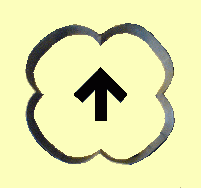
MAGNETOREFRACTIVE MOTIVE SYSTEMS
"In the case of two attracting spheres, or of a body not spherical,
the magnitude and direction of the force vary according to
more complicated laws. In electric and magnetic phenomena,
the magnitude and direction of the resultant force at any point
is main subject of investigation." J. C. Maxwell
This article introduces methods of achieving broken symmetry of electromagnetic interactions what allows exploitation of ambient magnetic fields. The set of experiments on magnetomotive interactions of moving objects - reveals elements of designs of "Magnetorefractive Motive Systems" (further 2MS) which have potential for building advanced utilities for generation of energy and transportation purposes.
1. REFRACTION OF MAGNETIC FLUX
Magnetic flux is considered to be similar with other electrodynamic phenomena such as electric current and light, and having similar properties for being conducted and/or refracted. Following experiments apply ceramic permanent magnets attached to curved screens made of siliconed-steel, which
conduct magnetic flux about 2000 time better than surrounding air. Screens influence lateral magnetic fields by curving North-South axes, extending fields along metal and causing refraction of magnetic flux such that vectors of magnetomotive forces incline toward perpendicular of screen's surfaces. Further from magnetic poles - magnetomotive forces decrease in strength and their vectors become straight perpendicular to magnetorefractive screens. Screen acts as medium allowing path of least action what cause asymmetric distribution of magnetic fields toward its screened side. Variations of geometrodynamics of magnetic fields vary its
potential of electromagnetic interactions.

asymmetric potential of electromagnetic interactions.

Outverted fork is applied for increasing efficiency of interaction of magnetic fields by creating discrepancy of directional potential of magnetomotive forces and magnetic momentum. Diagram below shows interactions of two magnets where one magnet is secured to rotate about vertical axis for being attracted or repealed by second magnet that is secured stationary. Both magnets have their magnetic axes on radius drawn from rotational axis of device. Rotating magnet is screened and tested as train for its asymmetry of interactions with stationary magnet as stator. Train's screen is secured having edges on radius and prong diverted toward clock-wise rotation.

Screen creates potential of preferred direction of motion of train and this potential manifests self in discrepancy of works of experimental device. Following diagram demonstrates train accelerating from statique equilibrium, where clock-wise moving train replaces half of circle, while count-clock rotation results just with one-eight of circle.
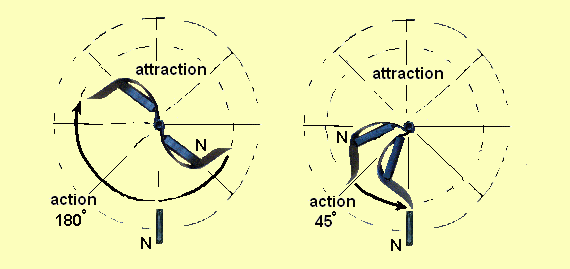
asymmetric directional potential for magnetomotive and electromotive forces.
Further experiment is developed by application of same outverted fork being train or rotor, and stator consisting of inverted forks secured perpendicular to radius of device or parallel to motion of train. Within stator's fork train is in potential well, where magnetomotive forces of interacting magnetic fields cause only-directional motion of train, replacing train from repulsive to attractive edges of stator's screens. There are three positions where train is in statique equilibrium: when train's and stator's screens have narrowest air-gap between them, or when train is outside-opposite of stator's fork. Moving along stator, - train accelerates and if stator's forks are connected in equipotential chain - train increases its velocity with every passed unit of stator. Connections of stators forks forms cogs diverted radially, where "slow" train may rest but moving train experience no reversive forces because of co-working alternating electric fields induced by motion of magnetic fields of train and stator.
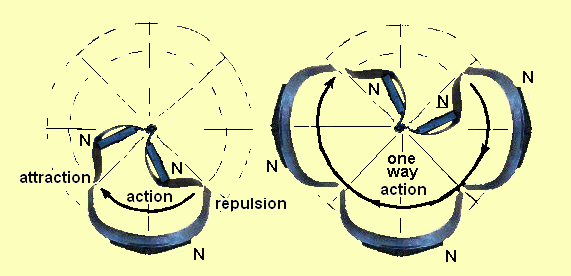
energy losses of electric transformers which release stray magnetic flux into environment.
Explained 2MS have been sufficiently tested in various designs where circular, linear or complex stators drive singular or multiple trains with no power input, unless inductive coils were applied. Productivity of stationary 2MS found to be independent from quantities of static or dynamic units, nor geographic orientation, but is
sensitive to proportions and synchronisation and increase with time of operation or action.
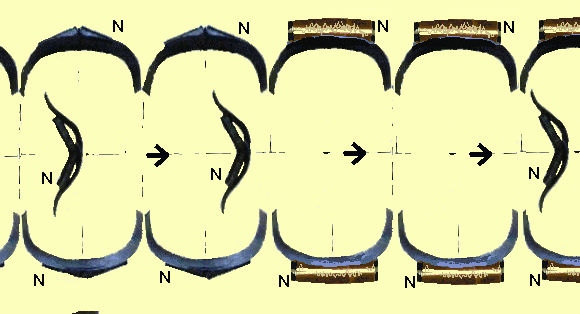
Clicking on image links to video demonstrating working prototype of 2MS linear motor.

In following experiment train has two magnetic poles interacting with "unipolar" stator.
Train consists of two mirror-symmetric outverted forks having reflection plain coinciding with radius of rotor that is secured to rotate about vertical axis. Stator consists of curved screens diverted outwardly and has magnets placed into cogs formed by connecting screens. Stator's magnets have their North-South axis radially and like poles diverted toward rotational axis of device. Static equilibrium is possible when stator's and rotor's magnets align their magnetic axes. Within stator's cogs - train is forced one-way and accelerates without cogging or reverse.
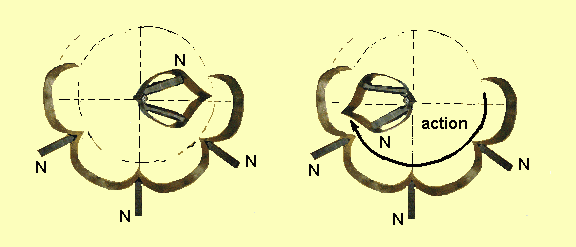
cause thrust vectoring perpendicular to force-lines of ambient fields.
Integral of magnetomotive forces results to force moving 2MS-vessels.

changes of geometry causes inclination of vector of thrust.
Clicking on image links to video demonstrating 2MS vessel orienting self and
moving Eastward.
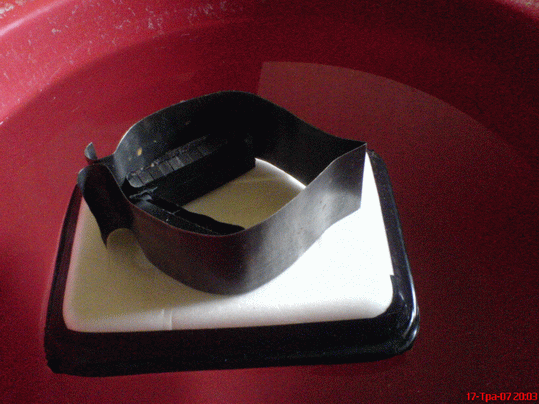
Groundbraking revelation of 2MS methods, allows generation of most of forms of energy by imploing phenomena of electromagnetic fields that has driving oure compasses since compass had been discovered.
New methods facilitate various utility designs which are underway to production lines.
The Good News of this revealation is: we can have much more by doing less;
we can utilyse 2MS in various ways and everywhere (also in Space);
Bed News is : some opportunistic conclussions might need re-consideration;
Also Good News: Aether exist.
Readers of this article are encouraged to replications of experiments, asking questions,
or demanding technical data, pictures or videos relating 2MS.
All rights reserved.
1st of June of 2007.
Published by Taras Leskiv - author of this publication and inventor of
"Magnetorefractive Motive Systems"
Mail to : ageofmagnetizm [at] yahoo.com
discussions of successfully build devices - only. Taras Leskiv, August of 2008
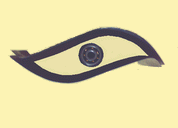
Breakthrough methods and technologies
Advanced efficiency of interactions
Perpetual mobiles
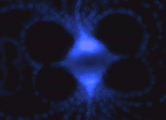
AGEOFMAGNETIZM
Last update: August of 2008